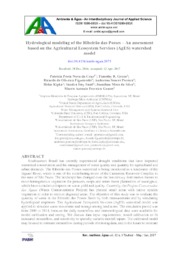Hydrological modeling of the Ribeirão das Posses: an assessment based on the Agricultural Ecosystem Services (AgES) watershed model.
Hydrological modeling of the Ribeirão das Posses: an assessment based on the Agricultural Ecosystem Services (AgES) watershed model.
Autoria: CRUZ, P. P. N.; GREEN, T. R.; FIGUEIREDO, R. de O.; PEREIRA, A. S.; KIPKA, H.; SAAD, S. I.; SILVA, J. M. da; GOMES, M. A. F.
Resumo: Abstract: Southeastern Brazil has recently experienced drought conditions that have impacted watershed conservation and the management of water quality and quantity for agricultural and urban demands. The Ribeirão das Posses watershed is being monitored as a headwater of the Jaguarí River, which is one of the contributing rivers of the Cantareira Reservoir Complex in the state of São Paulo. The landscape has changed over the last century from native forests to more homogeneous vegetation for pastures, crops and some forest plantations of eucalyptus, which have cumulative impacts on water yield and quality. Currently, the Projeto Conservador das Águas (Water Conservationist Project) has planted small areas with native species vegetation in order to recover degraded areas. The objective of this study was to evaluate the quantity of water in the Ribeirão das Posses Basin by both measurements and by simulating hydrological responses. The Agricultural Ecosystem Services (AgES) watershed model was applied to simulate water movement and storage among land areas. The simulation period was from 2009 to 2014, because the daily streamflow and meteorological data were available for model calibration and testing. We discuss data input requirements, model calibration to fit measured streamflow, and sensitivity to spatially variable rainfall inputs. The calibrated model may be used to estimate streamflow during periods of missing data, and in the future to estimate impacts of land use changes on stream water quantity and quality. Such information can be used in programs of payments for ecosystem services.
Ano de publicação: 2017
Tipo de publicação: Artigo de periódico
Unidade: Embrapa Meio Ambiente
Palavras-chave: Bacia hidrográfica, Clima, Climate, Ecosystem services, Hidrologia, Hidrological models, Water conservation, Watershed, Watershed model
Observações
1 - Por padrão são exibidas publicações dos últimos 20 anos. Para encontrar publicações mais antigas, configure o filtro ano de publicação, colocando o ano a partir do qual você deseja encontrar publicações. O filtro está na coluna da esquerda na busca acima.
2 - Para ler algumas publicações da Embrapa (apenas as que estão em formato ePub), é necessário ter, no celular ou computador, um desses softwares gratuitos. Sistemas Android: Google Play Livros; IOS: iBooks; Windows e Linux: software Calibre.
Acesse outras publicações
Acesse a Base de Dados da Pesquisa Agropecuária (BDPA) para consultar o acervo completo das bibliotecas da Embrapa.

